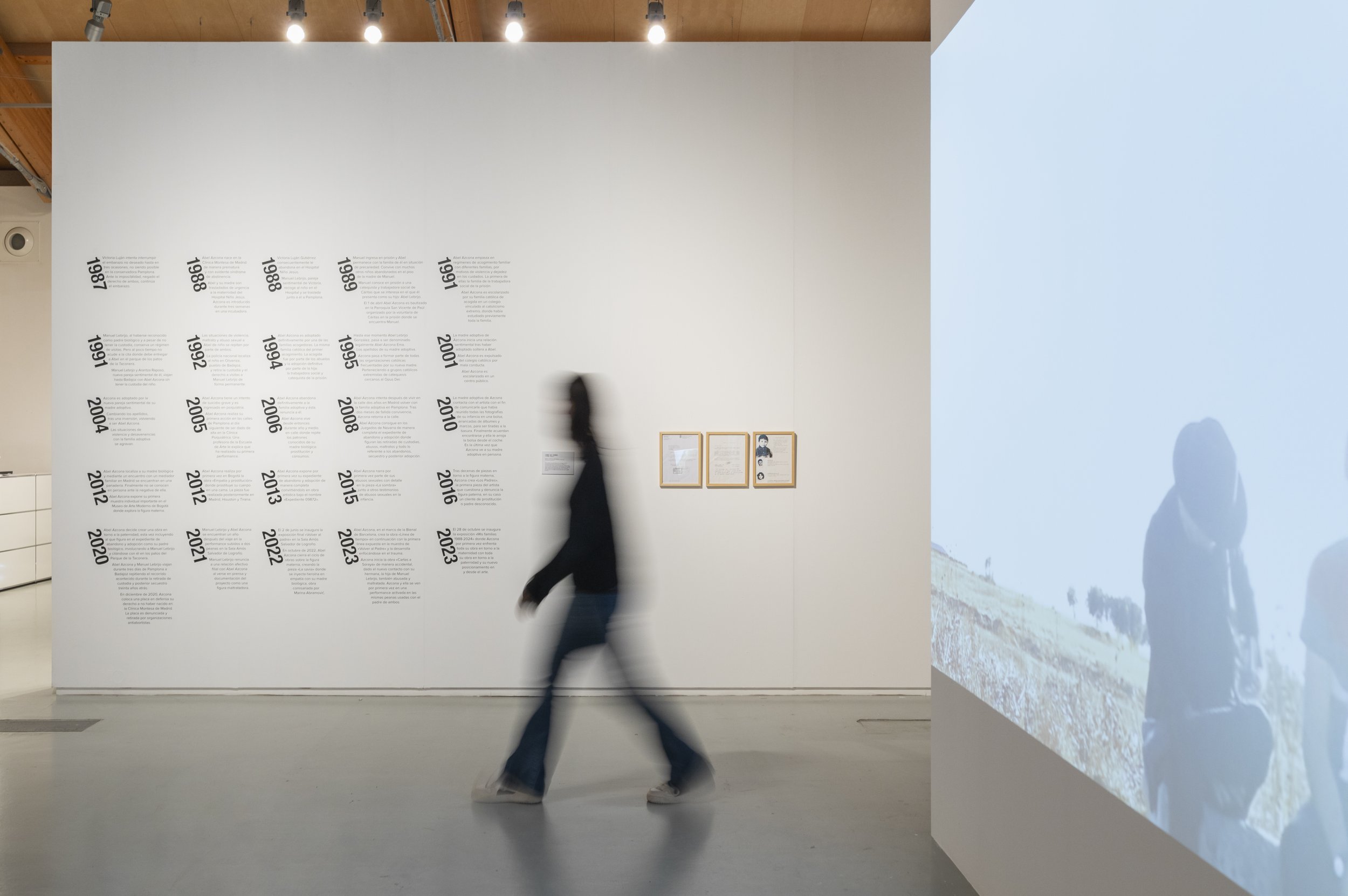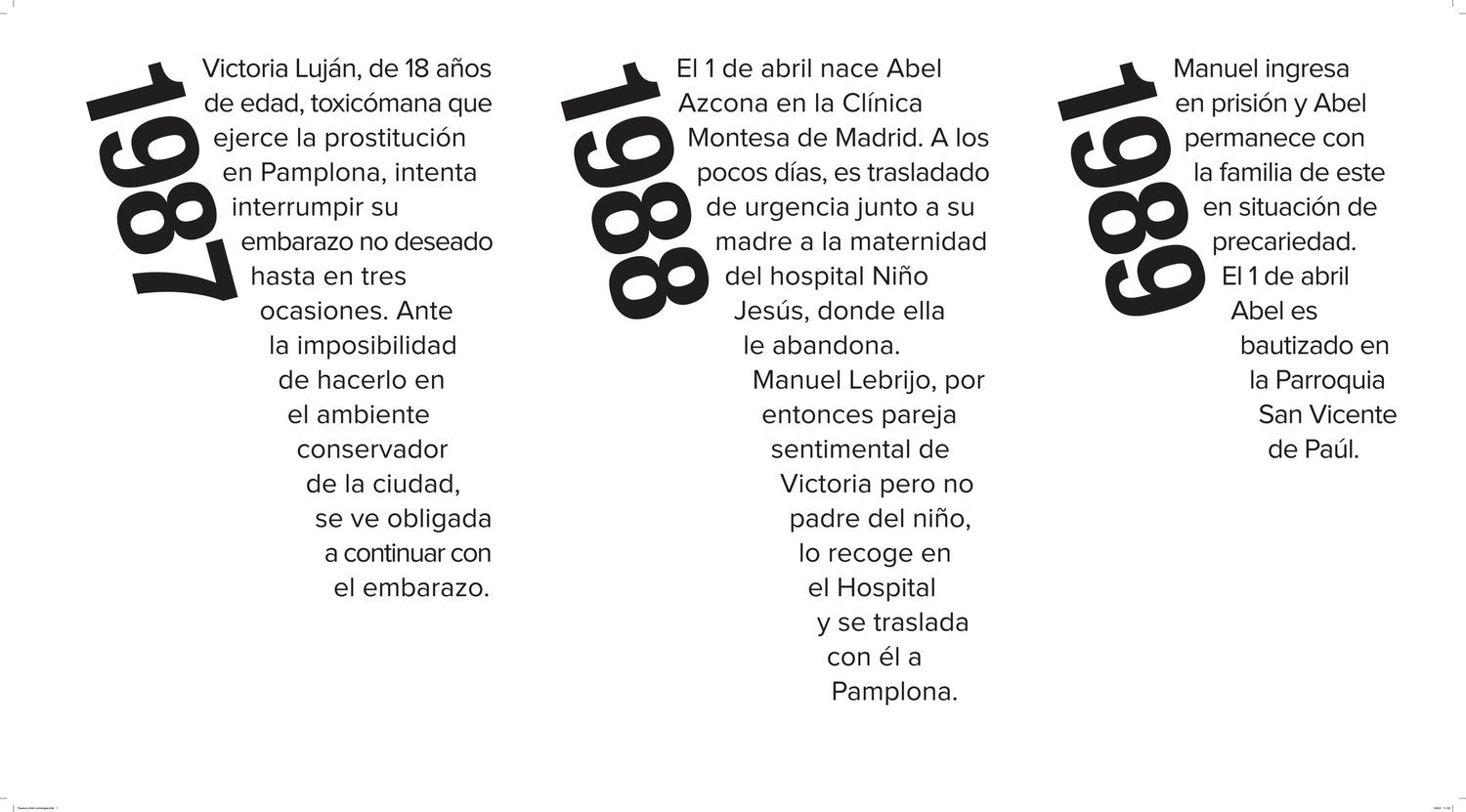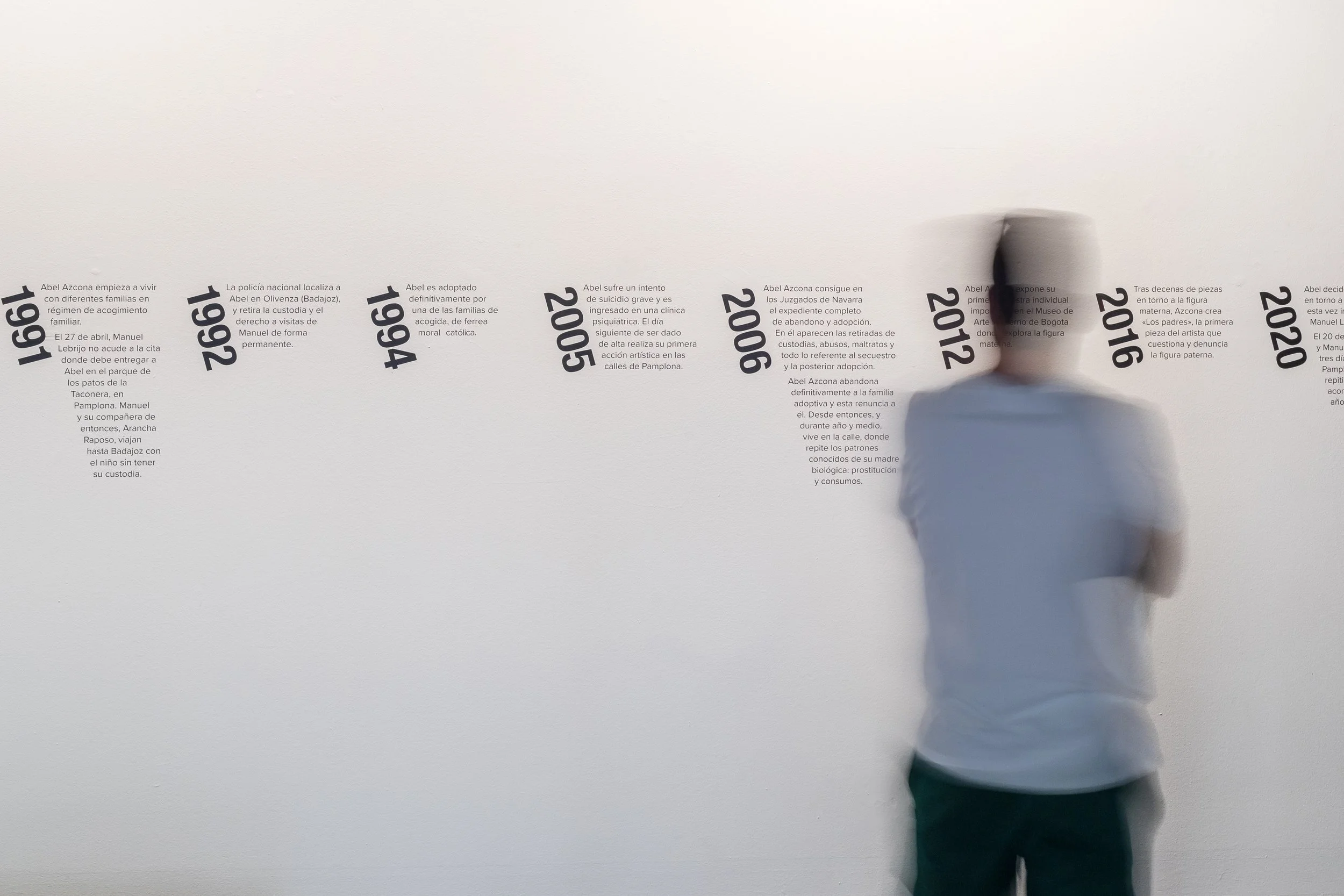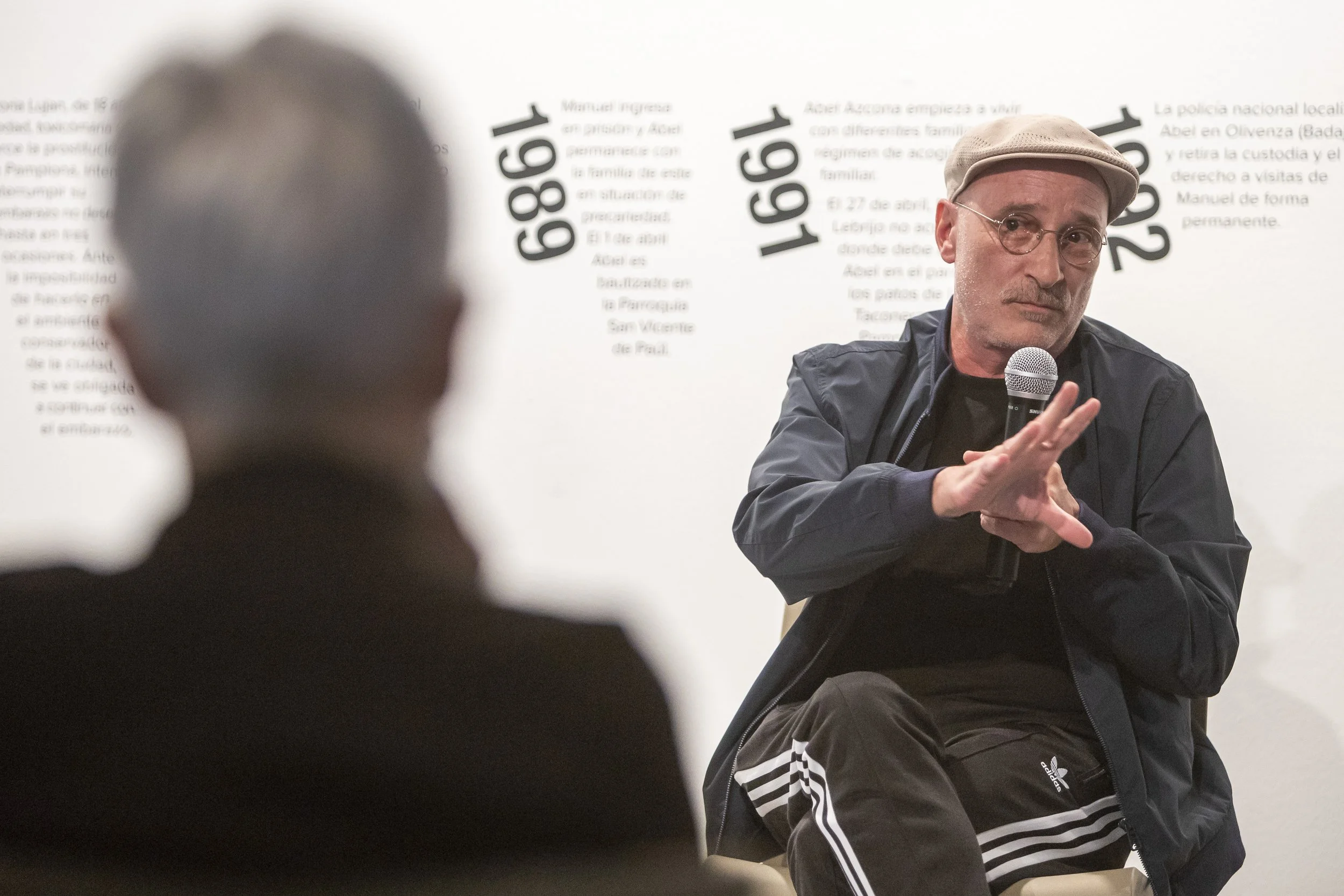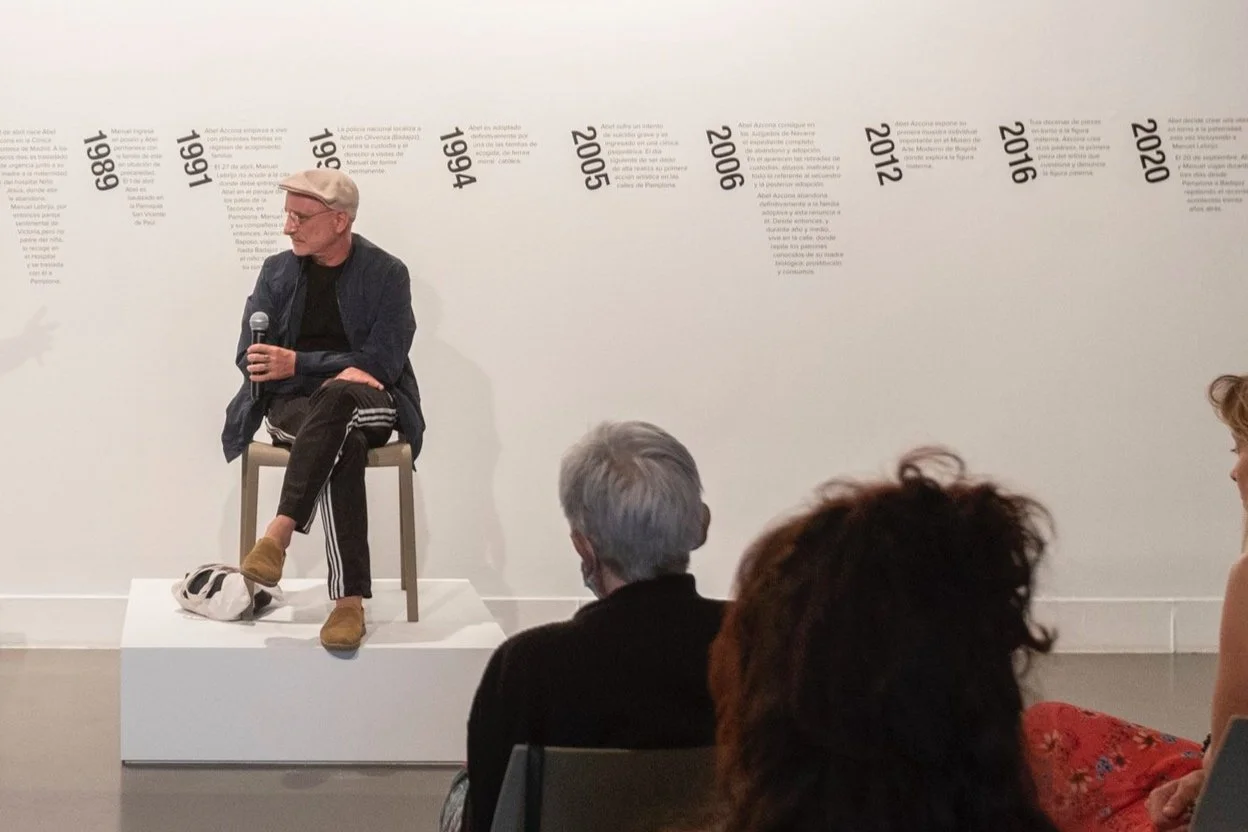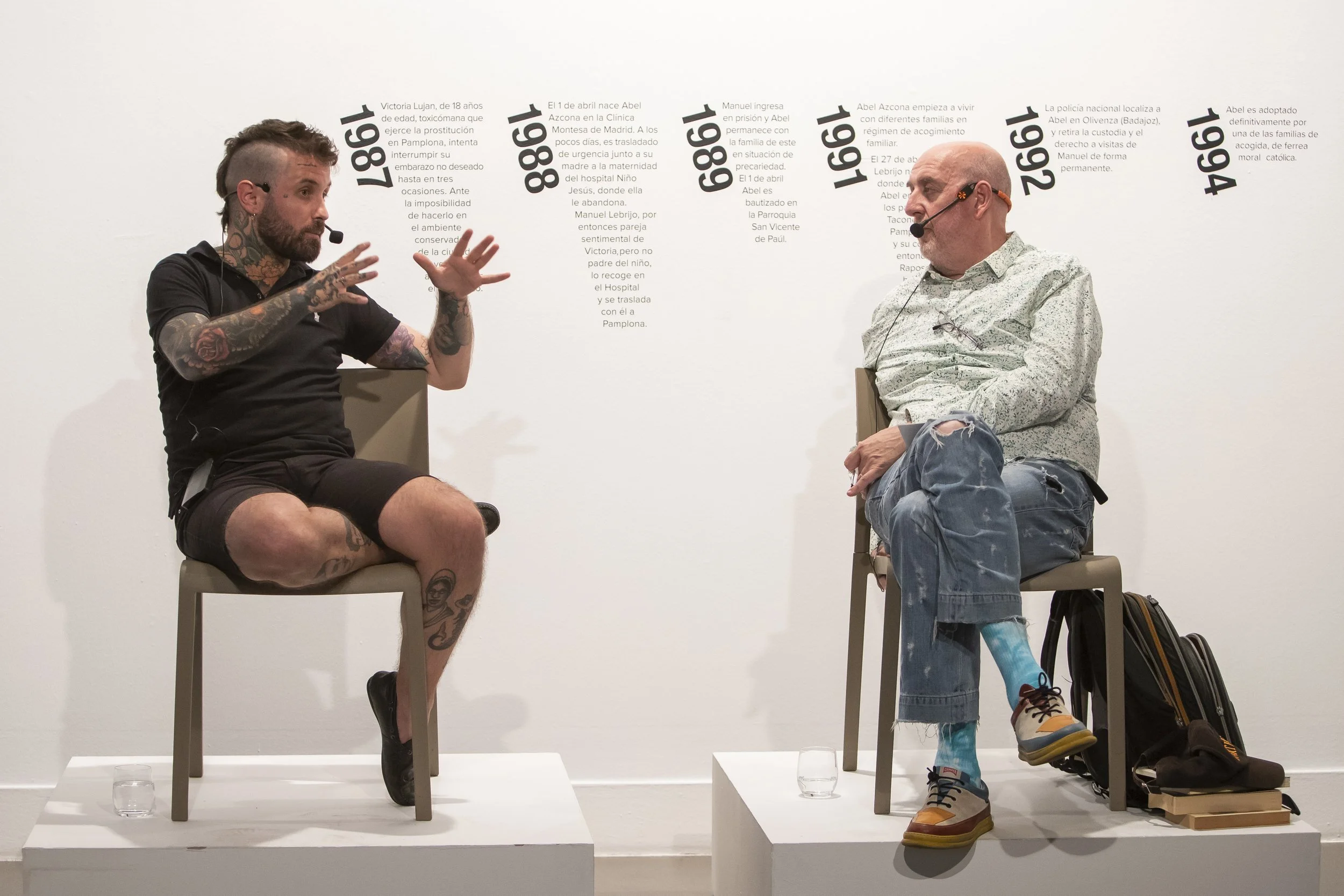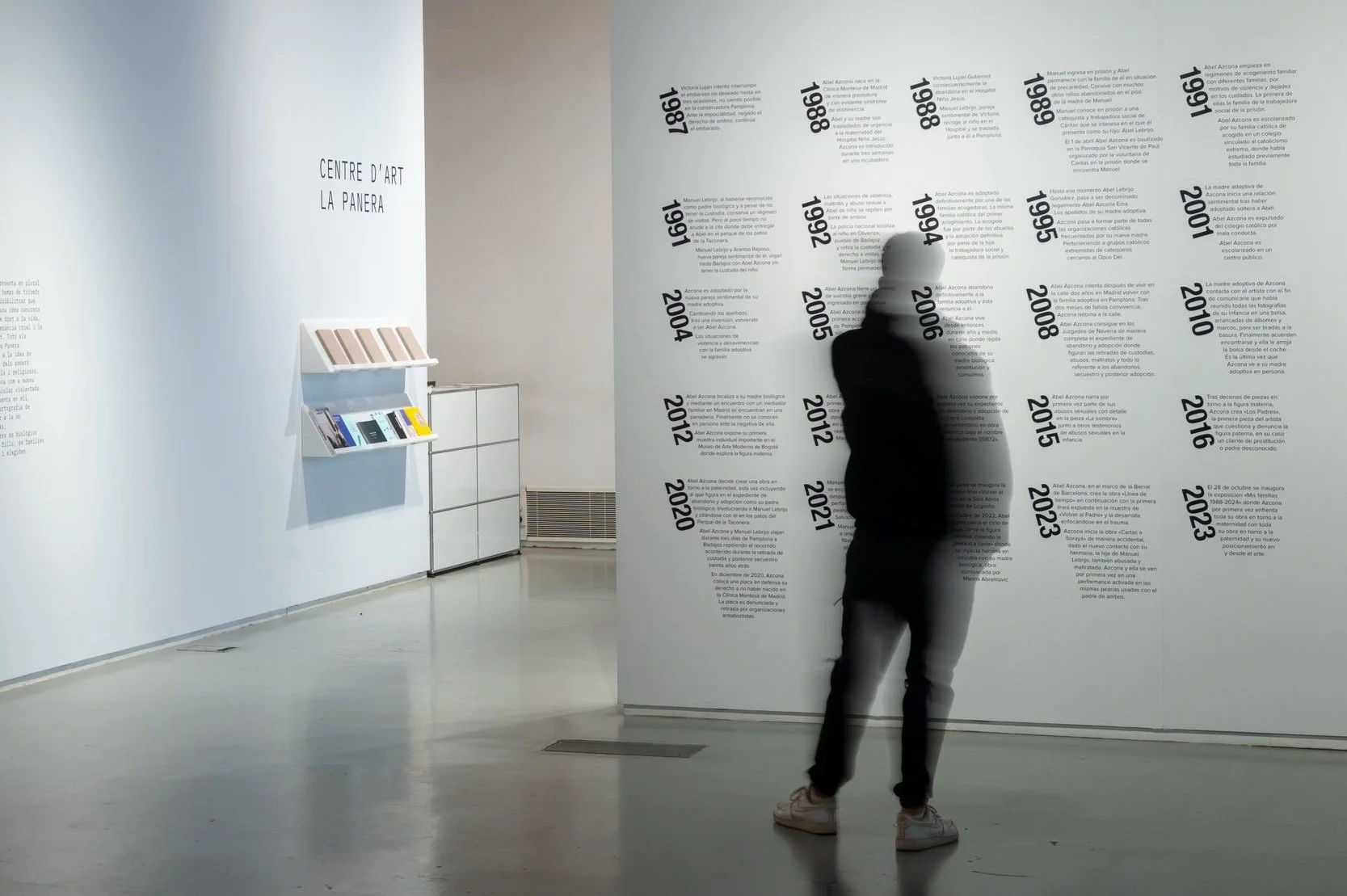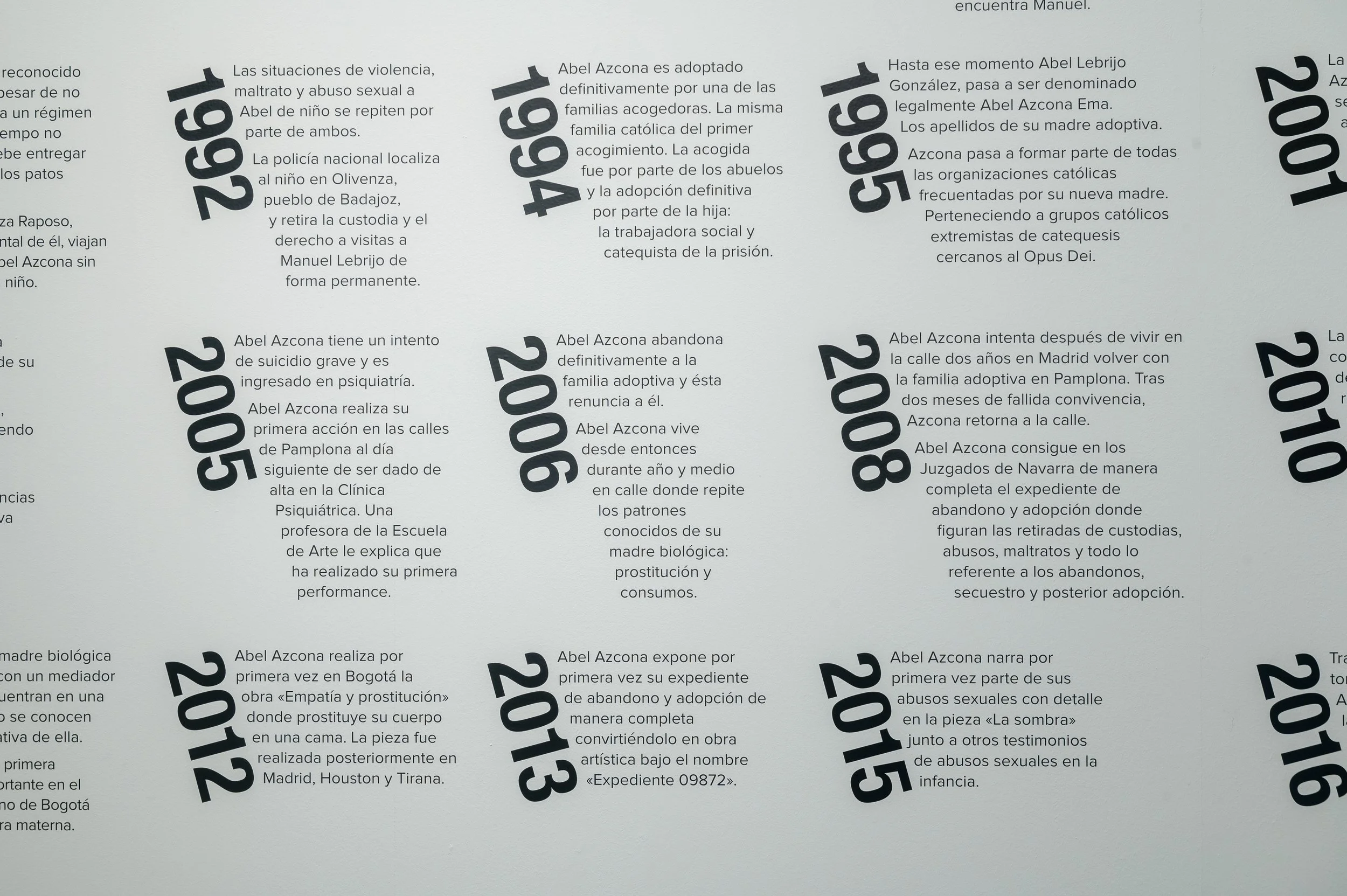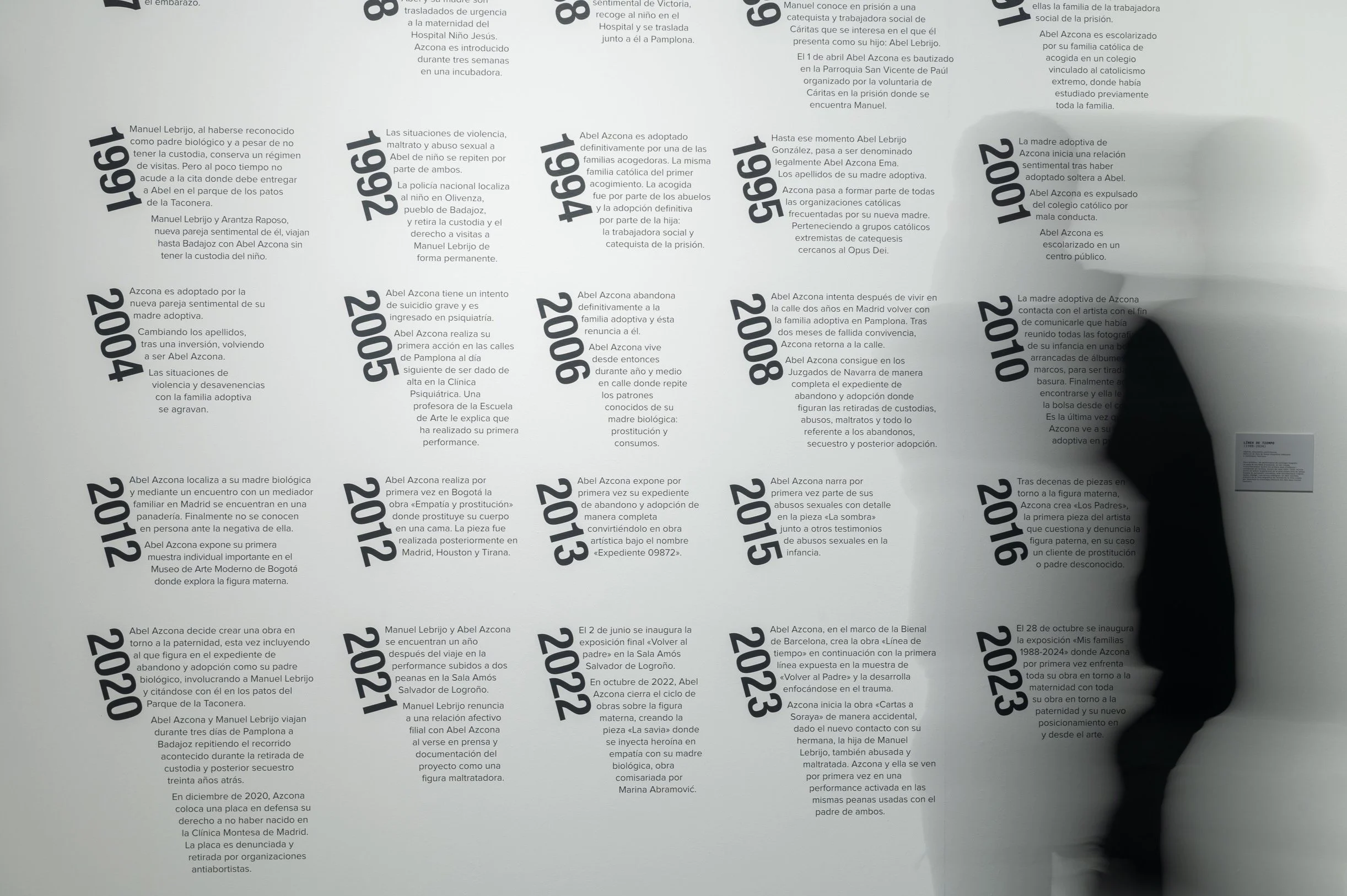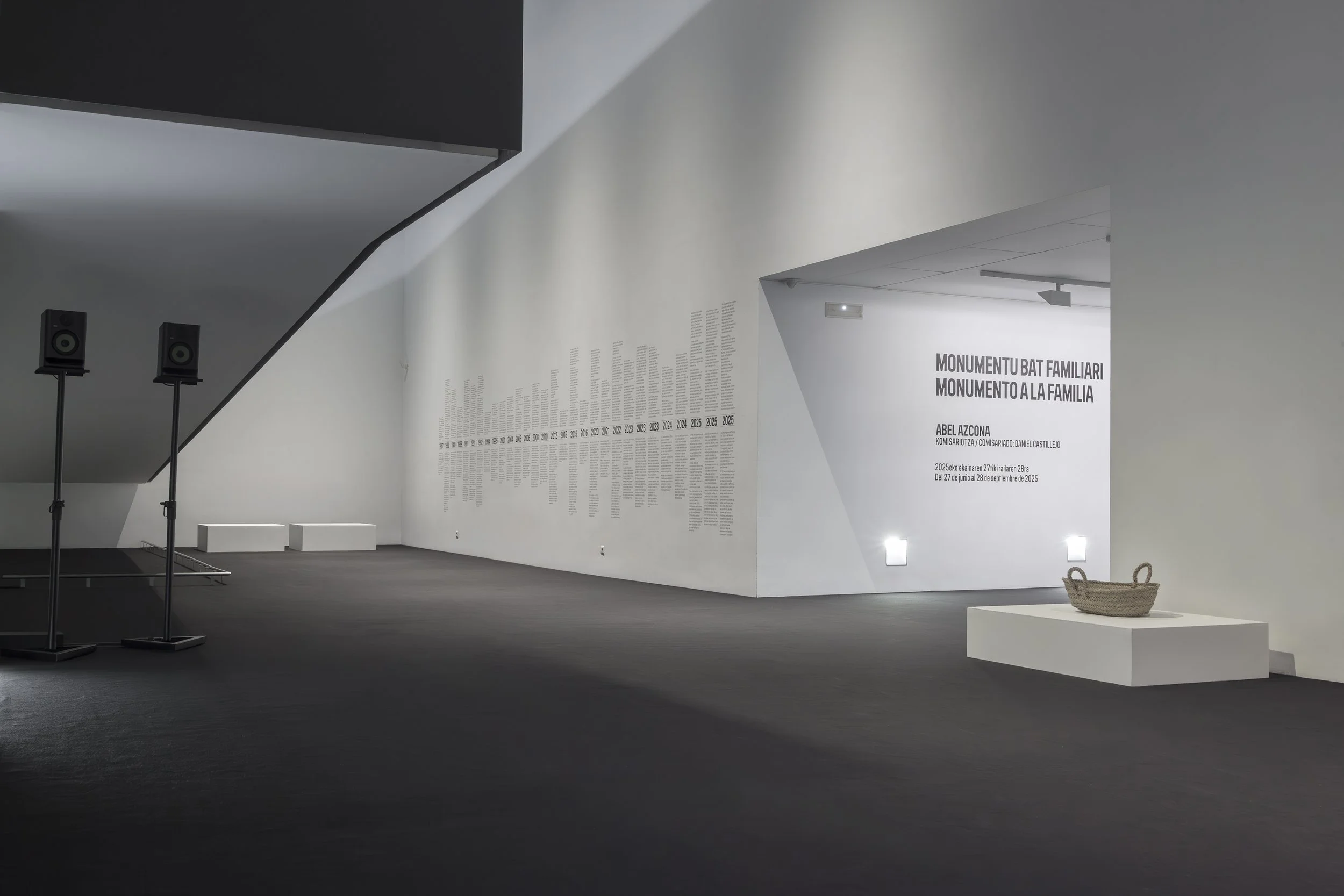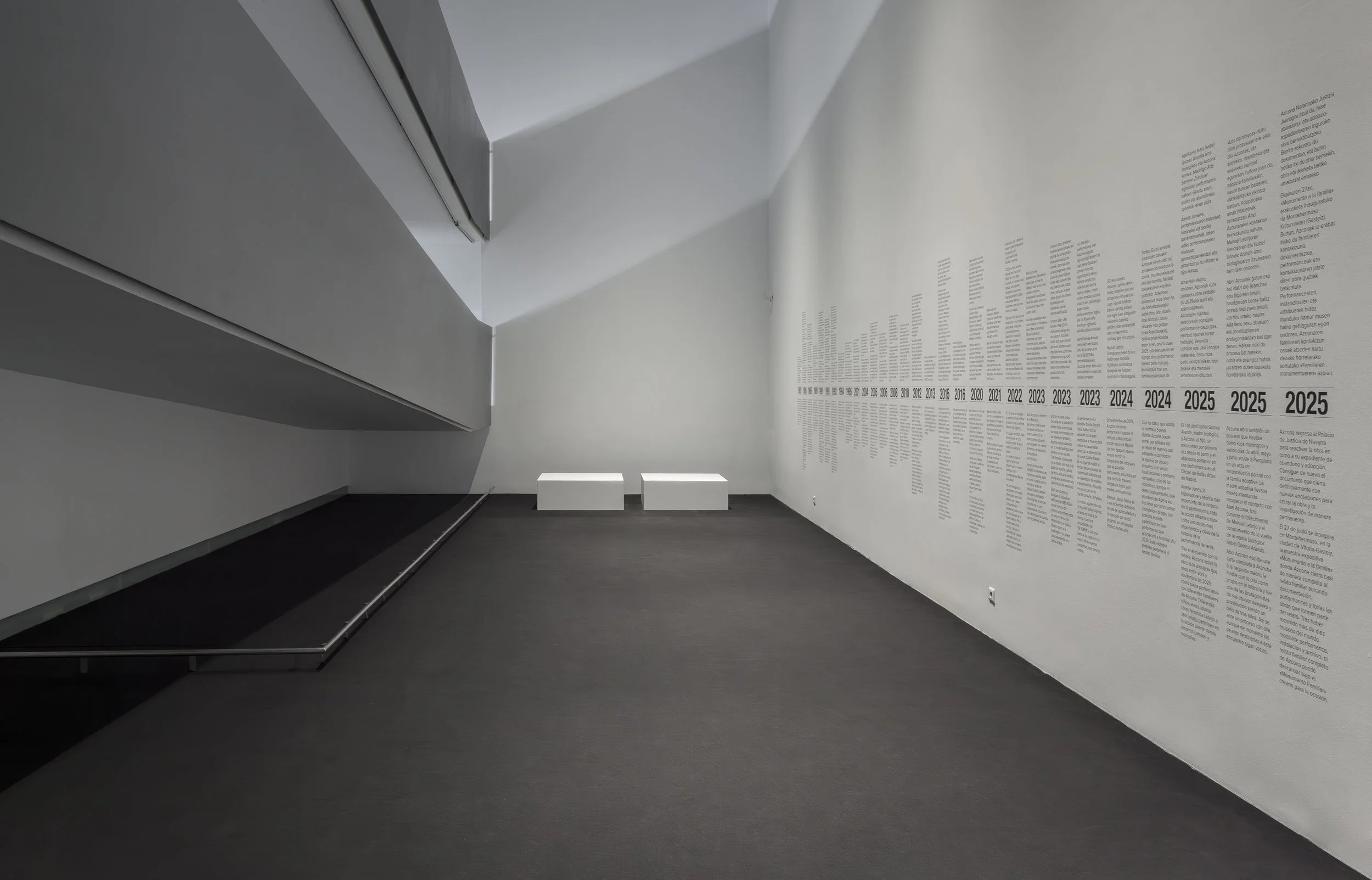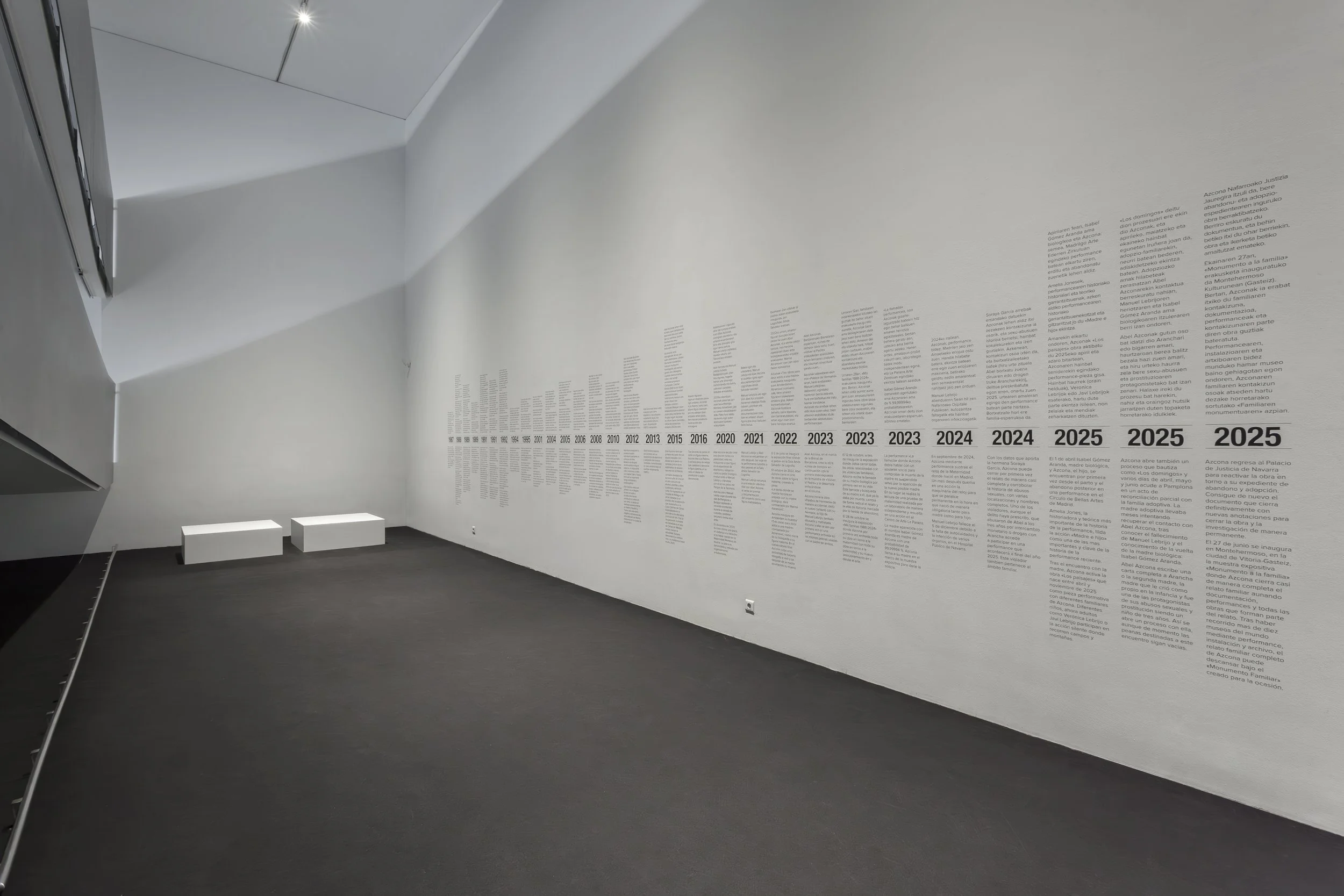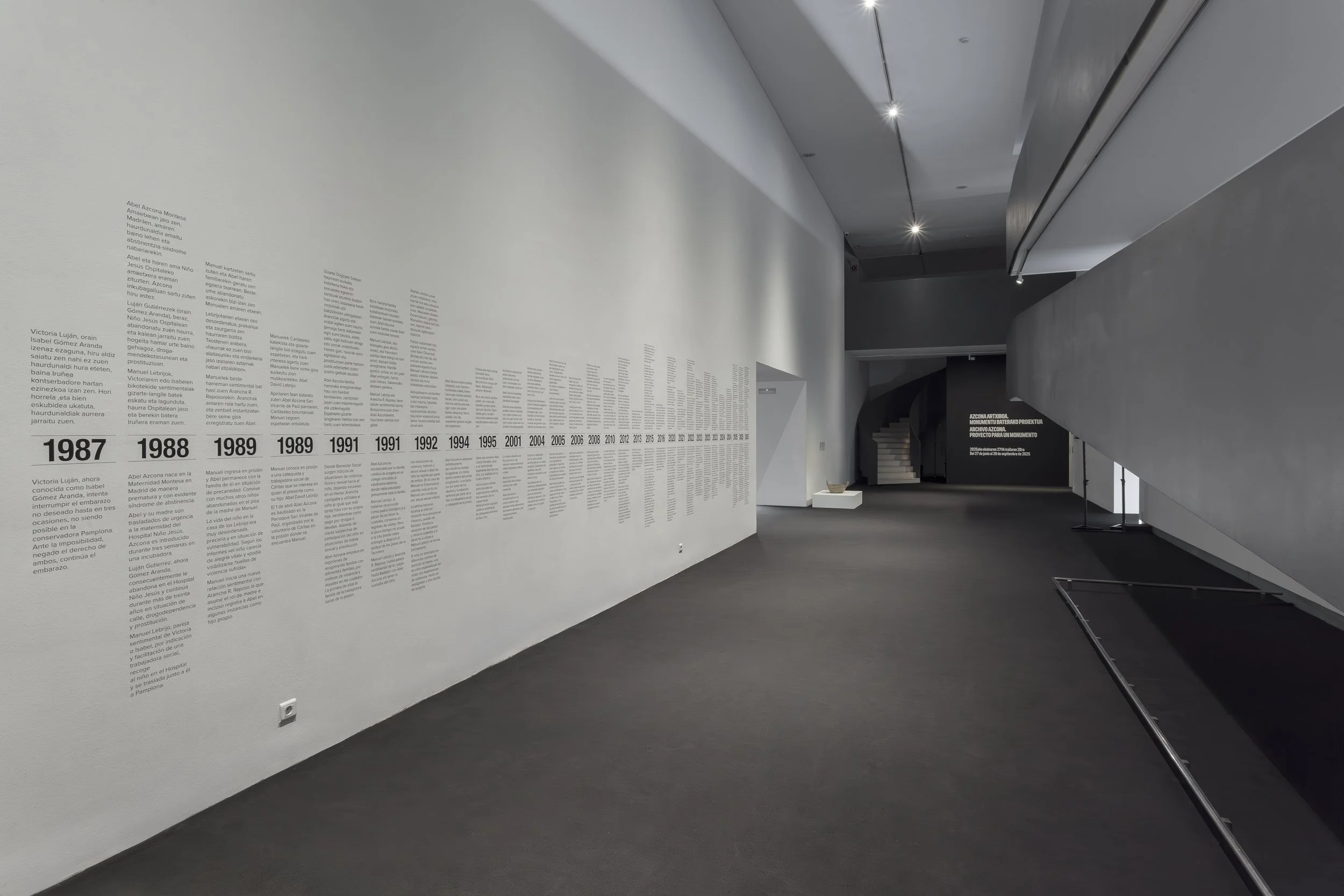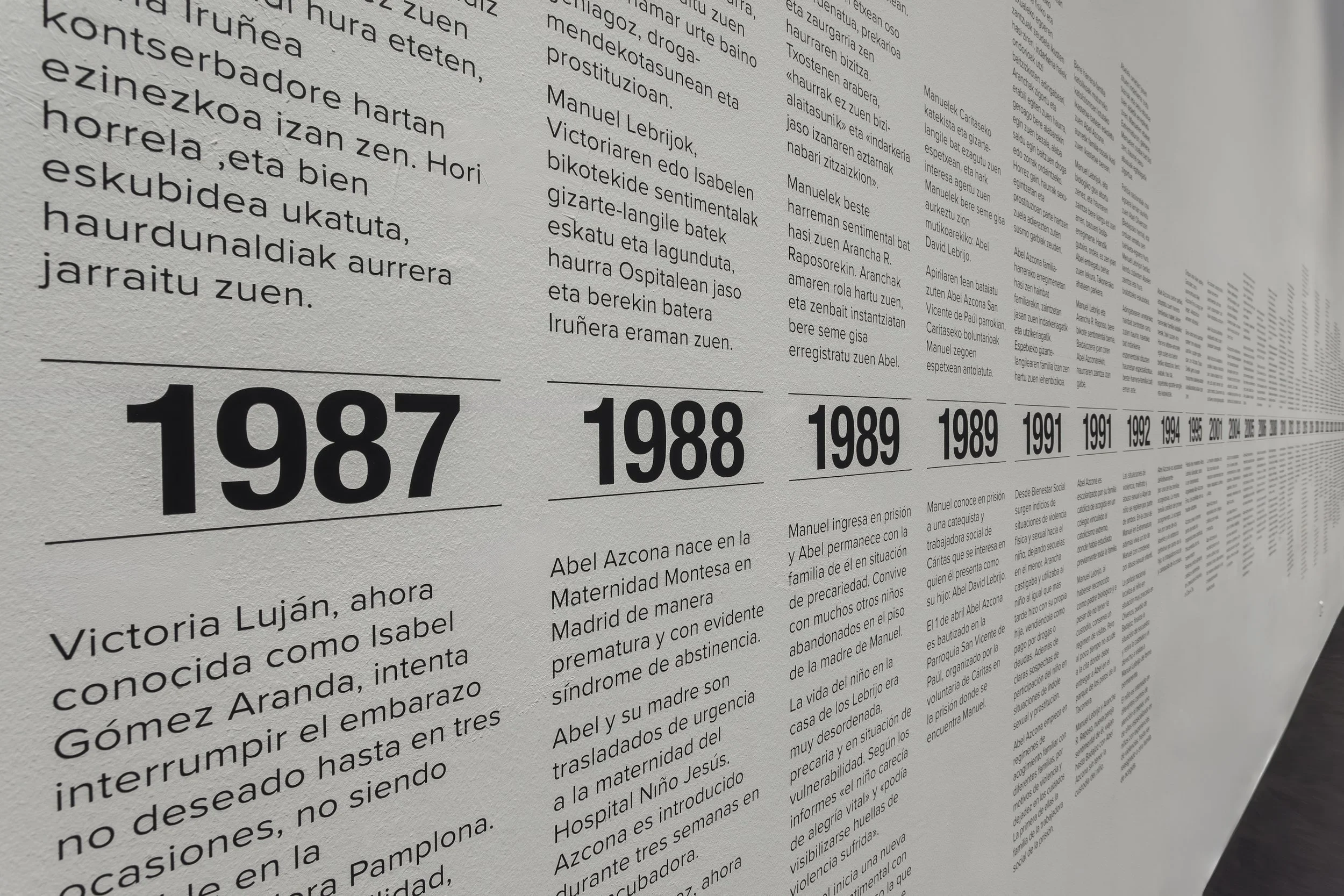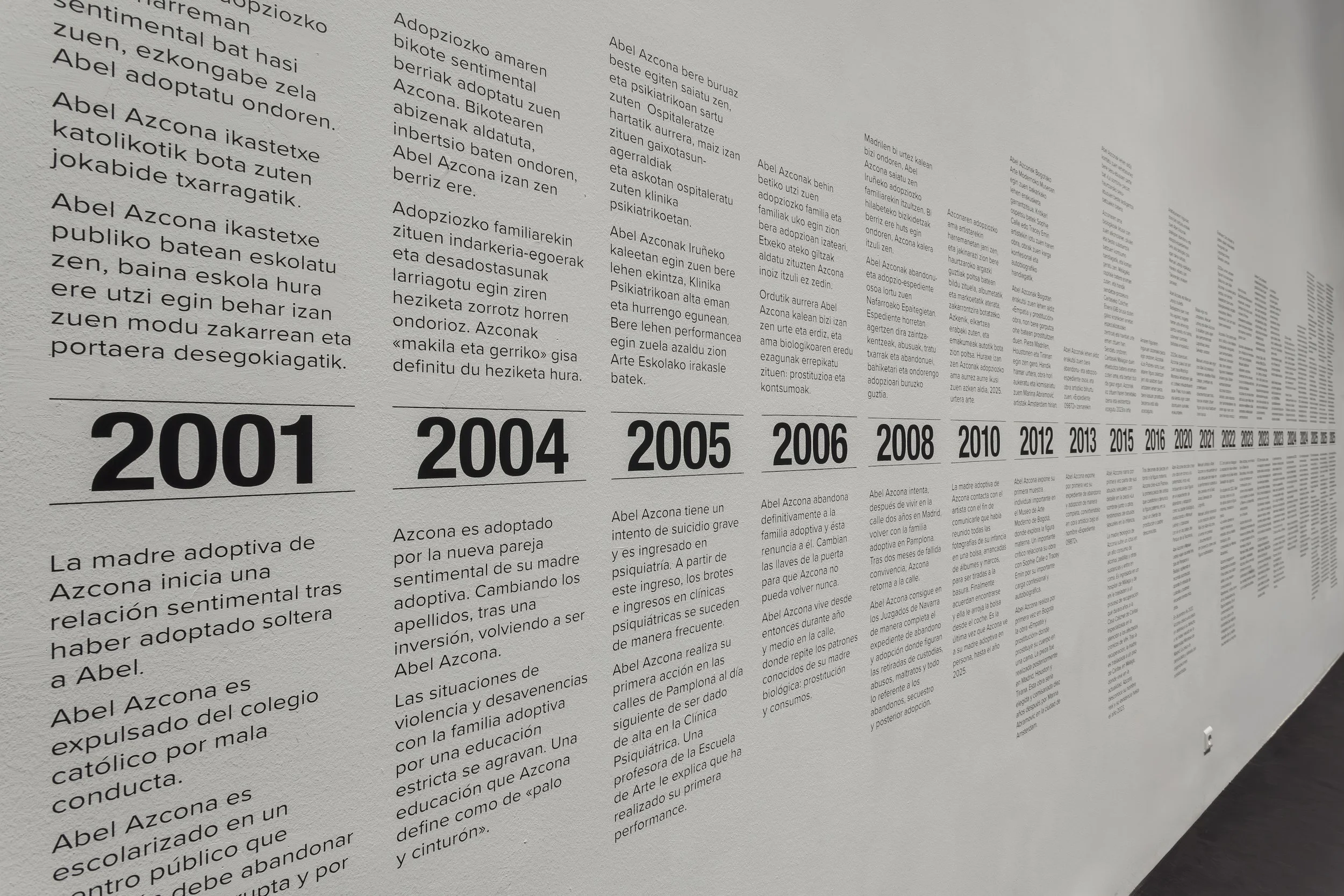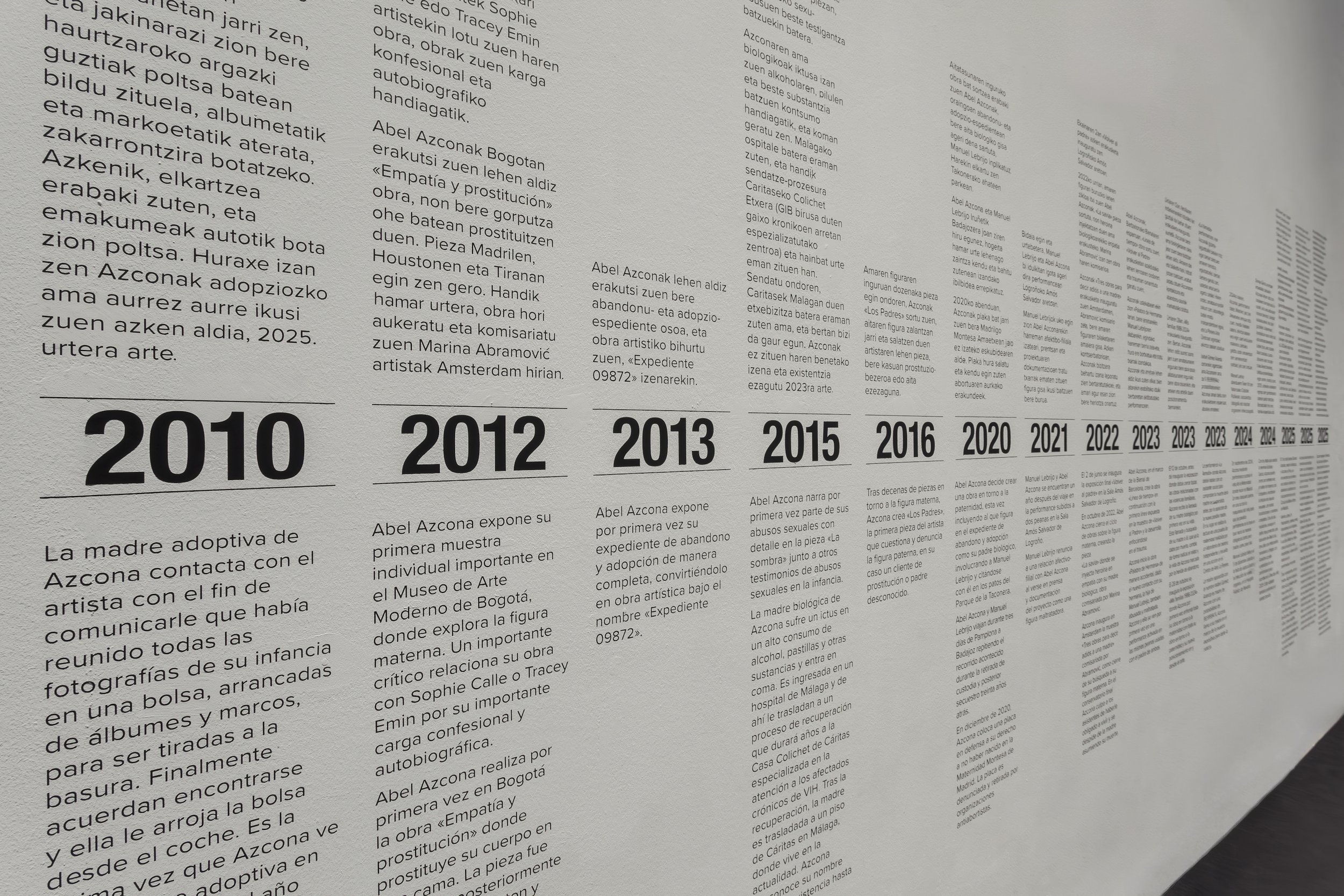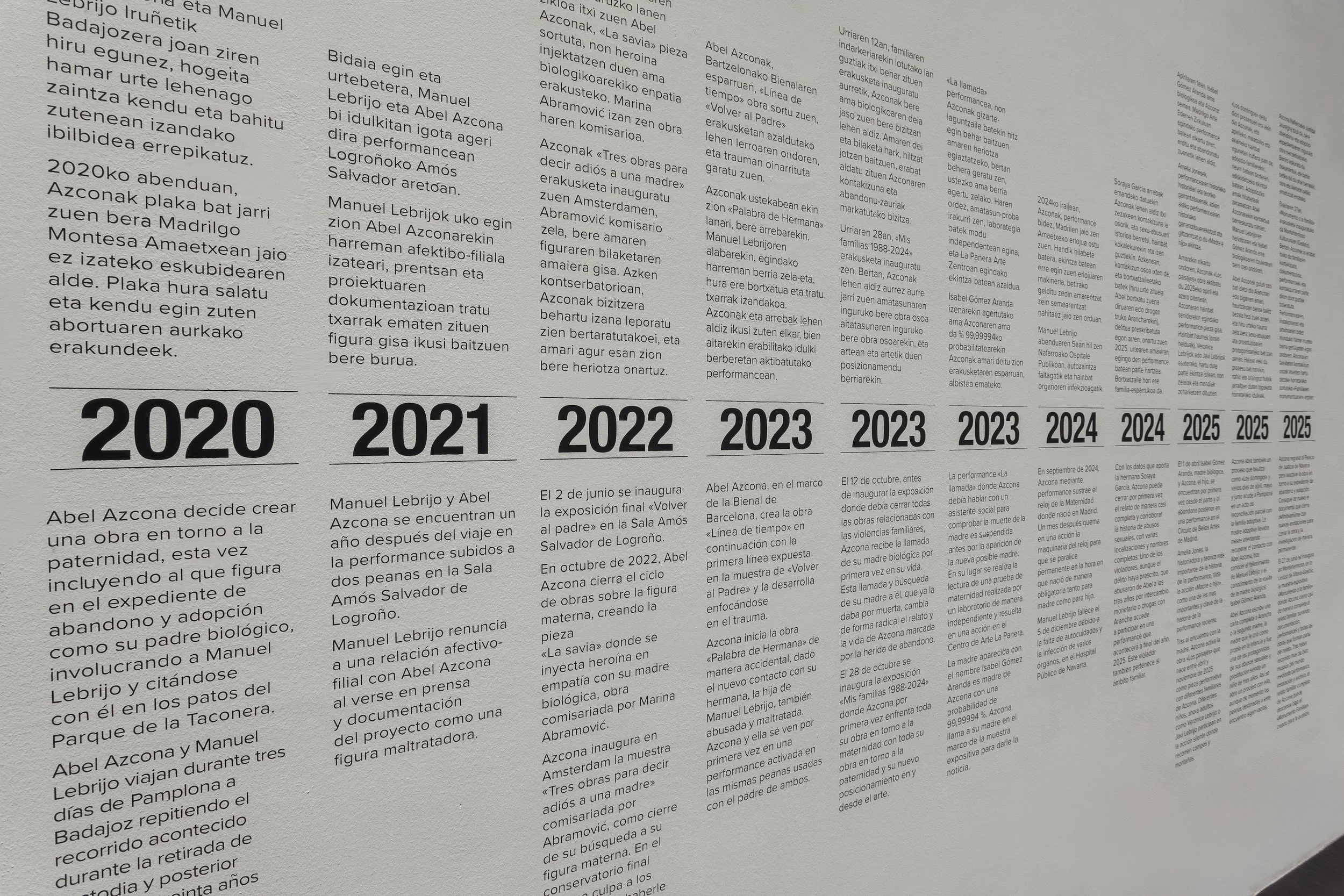Línea de tiempo [Time line] (1988-2024) is an artistic and performance work. The piece is process-based, having been created involuntarily during the artist’s early childhood development. During 2022 and 2023, Azcona activates in public the creation of his own timeline, based on traumatic events, with original documents, data, dialogues, and public narrations. One of artistic results of the artist’s timeline is the line created to describe Azcona’s chronology from his family ties. Object, documents, performance. Selection of biographical timeline on family issues.
Línea de tiempo (1988 - 2024) es una obra artística y de performance de contenido biográfico. La pieza tiene una base procesual, al ser creada de manera involuntaria durante los primeros años de infancia y crecimiento del artista. Durante los años 2022 y 2023 Azcona activa en público la creación de su propia línea de tiempo, basada en sucesos traumáticos, con documentación original, datos, diálogos y narraciones públicas. Uno de los resultados plásticos de la línea biográfica del artista es la línea creada para describir la cronología del artista desde sus vínculos familiares. Objeto, documentos, performance. Selección de línea de tiempo biográfica adecuada a temáticas familiares.
Last year, the idea arose of creating timelines to accompany the exhibitions and the new pieces with the aim of helping the viewer to understand all the movements and triggers for the performative pieces of a more process-based character. Thus, in Volver al padre [Returning to the father], the timeline is directed at all those traumatic events marked by abuse, neglect, or abandonment featuring father figures. The current show Mis familias 1988-2024 triples the length of the timeline, as it involves events not only featuring paternity but all type of family contamination. Although the timeline emerged as a guide conceived for the public, for me it has been one of the most intimate and cathartic processes possible. When I construct them, adapting them to each work or place, I do so in public during performative acts or open artistic residencies. Thus, many of them live and drink from the collectivization of the story.
To be able to read on a large white wall with vinyl all the painful experiences suffered is an exercise of great complexity but one that helps as an act of recognising and accepting trauma. Violence is not come to terms with until it is named, until it is read, until it is shared. The great revolution of people marked by trauma is sharing it until the bullies and the abusers are brought down and a face is put on the ghosts. I believe that in some way the total timeline –one not adapted to an exhibition framework – is pending, but I suppose that it will arrive. If the timeline on a wall hurts, imagine what it means to have it marked in the skin for ever.
Victoria Luján tries to interrupt her unwanted pregnancy on three occasions, but this is not possible in conservative Pamplona. In the face of this impossibility, with the rights of both denied, she continues with the pregnancy. Abel Azcona is born at the Montesa clinic in Madrid, premature and with evident signs of withdrawal syndrome. Abel and his mother are urgently transferred to the maternity unit of the Niño Jesús hospital. Azcona spends three weeks in an incubator. Victoria Luján Gutiérrez then abandons the child in the hospital. Manuel Lebrijo, Victoria’s romantic partner, collects the child from the hospital and takes him to Pamplona. Manuel is sent to prison and Abel stays with the former’s family in a precarious situation. He lives with many other abandoned children in the apartment of Manuel’s mother. In prison, Manuel meets a catechist and social worker for the Catholic charity Cáritas who is interested in the boy he presents as his son: Abel Lebrijo. On 1 April, Abel Azcona is baptized in the church of San Vincent de Paul, organized by the Cáritas volunteer at the prison where Manuel is detained.
The timeline is an installation of words and documents that consists of showing my history of pain without any type of timidity or sweetening. In a cold, almost aseptic way, I list each mistreatment, each abuse, and each abandonment that in some way has forged who I am today. In classes at the Catholic school, they got us to make historical chronologies, with dates that were important or one to celebrate; here the great difference is that I would have preferred than none of these events had ever happened.
El año pasado surgió la idea de crear lineas de tiempo que acompañaran las muestras expositivas y las nuevas piezas con el fin de ayudar al espectador a entender todos los momentos y detonantes de las piezas performativas de carácter más procesual. Así en Volver al padre la línea de tiempo estaba dirigida a todos aquellos acontecimientos traumáticos marcados por el abuso, la negligencia o el abandono protagonizados por figuras paternas. En la muestra actual Mis familias 1988-2024 triplicamos el tamaño de la línea de tiempo al ser sucesos no solo protagonizados por la paternidad sino por cualquier tipo de contaminación familiar. Aunque la línea de tiempo surge como una guía pensada para el público, para mi supone uno de los procesos más íntimos y catárticos posibles. La construcción de las mismas, adaptadas a cada obra o lugar, las realizo de manera pública en momentos de actos performativos o residencias artísticas en abierto. Así que muchas de ellas viven y beben de la colectivización del relato.
Poder leer en una gran pared blanca mediante vinilo todas las experiencias dolientes sufridas es un ejercicio de gran complejidad pero que ayuda como acto de reconocimiento y aceptación del trauma. La violencia no se asume hasta que se nombra, hasta que se lee, hasta que se comparte. La gran revolución de las personas marcadas por el trauma es compartirlo hasta tumbar a los maltratadores, a los abusadores y poner rostro a los fantasmas. Creo que de alguna manera está pendiente la linea de tiempo total y no únicamente adaptada a un marco expositivo, pero supongo que llegará. Si la linea de tiempo en una pared duele, imaginad lo que supone tenerla marcada en la piel para siempre.
Victoria Luján intenta interrumpir el embarazo no deseado hasta en tres ocasiones, no siendo posible en la conservadora Pamplona. Ante la imposibilidad, negado el derecho de ambos, continua el embarazo. Abel Azcona nace en la Clínica Montesa de Madrid de manera prematura y con evidente síndrome de abstinencia. Abel y su madre son trasladados de urgencia a la maternidad del Hospital Niño Jesús. Azcona es introducido durante tres semanas en una incubadora. Victoria Luján Gutierrez consecuentemente le abandona en el Hospital Niño Jesús. Manuel Lebrijo, pareja sentimental de Victoria, recoge al niño en el Hospital y se traslada junto a él a Pamplona. Manuel ingresa en prisión y Abel permanece con la familia de él en situación de precariedad. Convive con muchos otros niños abandonados en el piso de la madre de Manuel. Manuel conoce en prisión a una catequista y trabajadora social de Cáritas que se interesa en el que él presenta como su hijo: Abel Lebrijo. El 1 de abril Abel Azcona es bautizado en la Parroquia San Vicente de Paúl organizado por la voluntaria de Cáritas en la prisión donde se encuentra Manuel.
La línea de tiempo es una instalación de palabra y documento que consiste en mostrar mi historia de dolor sin ningún tipo de miramiento o edulcorado. De forma fría casi aséptica enumero cada maltrato, cada abuso y cada abandono que de alguna manera han forjado quien soy hoy. En clases del colegio católico nos hacían hacer cronologías históricas, con fechas importantes o a celebrar, aquí la gran diferencia es que hubiera preferido que ninguna de esos sucesos hubiera acontecido nunca.
1987 Victoria Luján tries to interrupt her unwanted pregnancy on three occasions, but this is not possible in conservative Pamplona. In the face of this impossibility, with the rights of both denied, she continues with the pregnancy.
1988 Abel Azcona is born at the Montesa clinic in Madrid, premature and with evident signs of withdrawal syndrome.
Abel and his mother are urgently transferred to the maternity unit of the Niño Jesús hospital. Azcona spends three weeks in an incubator.
Victoria Luján Gutiérrez then abandons the child in the hospital.
Manuel Lebrijo, Victoria’s romantic partner, collects the child from the hospital and takes him to Pamplona.
1989 Manuel is sent to prison and Abel stays with the former’s family in a precarious situation. He lives with many other abandoned children in the apartment of Manuel’s mother.
In prison, Manuel meets a catechist and social worker for the Catholic charity Cáritas who is interested in the boy he presents as his son: Abel Lebrijo.
On 1 April, Abel Azcona is baptized in the church of San Vincent de Paul, organized by the Cáritas volunteer at the prison where Manuel is detained.
1991 Abel Azcona starts foster care with different families, because of the violence and negligence in his care. The first of these is the family of the prison social worker.
Abel Azcona is schooled by his Catholic foster family in a school linked to extreme Catholicism, where the whole family had previously been educated.
Manuel Lebrijo, recognized as the biological father but not having custody, retains visiting rights. But before long he does not attend the meeting where he is supposed to hand back Abel at the duck pond in the Taconera Park.
Manuel Lebrijo and his new romantic partner Arantza Raposa travel to Badajoz with Abel Azcona without having custody of the child.
1992 Situations of violence, mistreatment, and sexual abuse of Abel by both parties occur repeatedly.
The national police find the boy in Olivenza, a village of Badajoz, and custody and visiting rights are removed from Manuel Lebrijo on a permanent basis.
1994 Abel Azcona is definitively adopted by one of the foster families. The same Catholic family of the first fostering. The fostering was done by the grandparents and the definitive adoption by their daughter: the social worker and catechist at the prison.
1995 From this point Abel Lebrijo González is legally named Abel Azcona Ema. The surnames of his adoptive mother.
Azcona becomes part of all the Catholic organizations frequented by his new mother. They belong to extreme Catholic catechesis groups close to Opus Dei.
2001 Azcona’s adoptive mother begins a romantic relationship, after having adopted Abel as a single woman.
Abel Azcona is expelled from the Catholic school for bad behaviour.
Abel Azcona receives schooling at a public centre.
2004 Azcona is adopted by his mother’s new romantic partner. After reversing the order of the surnames, he returns to being Abel Azcona.
Situations of violence and disagreement with the adoptive family become worse.
2005 Abel Azcona makes a serious attempt at suicide and is admitted to a psychiatric hospital.
Abel Azcona carries out his first action in the streets of Pamplona, the day after being discharged from the psychiatric clinic. A professor at the School of Art explains to him that he has made his first performance.
2006 Abel Azcona definitively abandons the adoptive family, which then renounces him.
Abel Azcona then lives for a year and a half in the street, where he repeats the known patterns of his biological mother: prostitution and drug use.
2008 After living in the street in Madrid for two years, Abel Azcona tries to return to the adoptive family in Pamplona. After two months of failed cohabitation, Azcona returns to the street.
Abel Azcona obtains from the Navarra courts the full file on his abandonment and adoption, which details the withdrawals of custody, abuse, maltreatment, and everything related the abandonment, kidnapping, and later adoption.
2010 Azcona’s adoptive mother contacts the artist to tell him that she had put all the photographs of his childhood – torn out of albums and frames – into a bag to be thrown into the rubbish. They eventually agree to meet, and she throws him the bag from her car. It is the last time that Azcona sees his adoptive mother in person.
2012 Abel Azcona has his first individual exhibition, which explores the mother figure, at the Museo de Arte Moderno in Bogotá.
Abel Azcona premieres in Bogotá the work “Empatía y prostitución” [Empathy and prostitution], where he prostitutes his body in a bed. The work is later performed in Madrid, Houston, and Tirana.
2013 Abel Azcona exhibits for the first time his full abandonment and adoption file, converting it into an artwork under the title “Expediente 09872” [File 09872].
2015 Abel Azcona narrates for the first time his sexual abuse in detail in the piece “La sombra” [The shadow] together with other testimonies of child sex abuse.
2016 After dozens of pieces about the mother figure, Azcona creates “Los Padres” [The fathers], the first piece in which the artist questions and denounces the paternal figure, in his case an unknown father, the client of a prostitute.
2020 Abel Azcona decides to create a work about fatherhood, this time including the man who appears in the abandonment and adoption certificate as his biological father, involving Manuel Lebrijo and making an appointment to meet him at the duck pond in the Taconera Park.
Abel Azcona and Manuel Lebrijo travel for three days from Pamplona to Badajoz, repeating the route taken during the withdrawal of custody and later kidnapping thirty years earlier.
In December 2020, Azcona places a plaque in defence of his right not to have been born at the Montesa clinic in Madrid. The plaque is denounced and removed by anti-abortion organizations.
2021 Manuel Lebrijo and Abel Azcona meet a year after the journey in a performance in which they stand on two pedestals in the Sala Amós Salvador in Logroño.
Manuel Lebrijo renounces an affective filial relationship with Abel Azcona after seeing himself described in the press and the documentation of the project as an abusive figure.
2022 On 2 June the final exhibition “Volver al padre” [Return to the father] opens at the Sala Amós Salvador in Logroño.
In October 2022, Abel Azcona closes the cycle of works about the mother figure, creating the piece “La savia” [The sap] where he injects heroin in empathy with his biological mother, a work curated by Marina Abramović.
2023 Abel Azcona, in the context of the Biennial of Barcelona, creates the work “Línea de tiempo” [Timeline], as a continuation of the first line exhibited in the exhibition “Volver al Padre” and develops it focusing on trauma.
Azcona starts the work “Cartas a Soraya” [Letters to Soraya] in an accidental way, given the new contact with his sister, Manuel Lebrijo’s daughter, also abused and mistreated. They meet each other for the first time in a performance that takes places on the same pedestals used with their father.
On 28 October the exhibition “Mis familias 1988-2024” [My families 1988-2024] opens, in which for the first time Azcona places all his work around motherhood face to face with all his work about fatherhood and his new positioning in and from art.
Timeline Montage Adapted to the Figure of the Father in the Framework of the Exhibition Return to the Father by Abel Azcona at the Sala Amós Salvador in Logroño. / Montaje de la Linea de tiempo adaptada a la figura del padre en el marco de la exposición Volver al Padre de Abel Azcona en la Sala Amós Salvador de Logroño.
Timeline Montage Adapted to the Figure of the Father in the Framework of the Exhibition Return to the Father by Abel Azcona at the Sala Amós Salvador in Logroño. / Montaje de la Linea de tiempo adaptada a la figura del padre en el marco de la exposición Volver al Padre de Abel Azcona en la Sala Amós Salvador de Logroño.
Timeline Adapted to the Figure of the Father in the Framework of the Exhibition Return to the Father by Abel Azcona at the Sala Amós Salvador in Logroño. / Linea de tiempo adaptada a la figura del padre en el marco de la exposición Volver al Padre de Abel Azcona en la Sala Amós Salvador de Logroño.
Monument to the Family” at Montehermoso in Vitoria—an exhibition dedicated to nearly all of Azcona’s works about or against the idea of family—opened the largest timeline to date, this time in Spanish and Basque. / Monumento a la Familia en Montehermoso, Vitoria, una muestra dedicada a casi la totalidad de piezas de Azcona en torno o en contra a la idea de familia, inauguró la linea de tiempo más grande hasta la fecha, esta vez en castellano y euskera.
1987
Victoria Luján, now known as Isabel Gómez Aranda, attempts to terminate an unwanted pregnancy on three occasions, which is not possible in conservative Pamplona. Faced with the impossibility and denied the right to do so, she continues the pregnancy.
1988
Abel Azcona is born prematurely at the Montesa Maternity Hospital in Madrid, showing evident withdrawal syndrome.
Abel and his mother are urgently transferred to the maternity unit of the Niño Jesús Hospital. Azcona is placed in an incubator for three weeks.
Luján Gutiérrez, now Gómez Aranda, consequently abandons him at the Niño Jesús Hospital and continues for more than thirty years living on the streets, with drug dependency and in prostitution.
Manuel Lebrijo, Victoria/Isabel’s romantic partner, following the guidance and facilitation of a social worker, collects the child from the hospital and moves with him to Pamplona.
1989
Manuel is sent to prison and Abel remains with Manuel’s family in precarious conditions. He lives with many other abandoned children in the home of Manuel’s mother.
Life for the child in the Lebrijo household is very disorderly, precarious, and vulnerable. According to reports, “the child lacked any vital joy” and “traces of suffered violence could be seen.”
Manuel begins a new romantic relationship with Arancha R. Raposo, who assumes the role of mother and even registers him in some instances as her own son.
In prison, Manuel meets a catechist and social worker from Cáritas who takes an interest in the child he presents as his son: Abel David Lebrijo.
On April 1, Abel Azcona is baptized at the San Vicente de Paúl Parish, organized by the Cáritas volunteer at the prison where Manuel is being held.
1991
Social Welfare identifies signs of physical and sexual violence toward the child, leaving lasting effects. Arancha punished and used the child, just as she would later do with her own daughter, selling her as payment for drugs or debts. There were also clear suspicions that the child was involved in situations of a sexual nature and prostitution.
Abel Azcona begins family foster care with different families due to violence and neglect. The first of these families is that of the prison social worker.
Abel is enrolled by his Catholic foster family in a school linked to extreme Catholicism, where the entire family had previously studied.
Although Manuel Lebrijo is recognized as the biological father and does not have custody, he retains visitation rights. But shortly afterward he fails to show up at the meeting point where he is supposed to return Abel, in the duck park at La Taconera.
Manuel Lebrijo and Arantza R. Raposo, his new partner, travel with Abel Azcona to Badajoz without having legal custody of the child.
1992
Situations of violence, mistreatment, and sexual abuse of Abel as a child are repeated by both adults. Living in Manuel’s home in Extremadura is also Manuel’s uncle, who had been convicted of child sexual abuse.
The National Police locate the child in very precarious conditions in Olivenza, a village in Badajoz, end the situation of kidnapping, and permanently withdraw custody and visitation rights from Manuel Lebrijo.
1992
The child is placed in various child-care centers, one of them specialized in children who have experienced violence, until he is reassigned to another foster family.
1994
Abel Azcona is definitively adopted by one of the foster families—the same Catholic family from his first foster placement. The foster care was carried out by the grandparents, and the definitive adoption by their daughter, the social worker and catechist from the prison.
1995
Until that moment known as Abel Lebrijo González, he legally becomes Abel Azcona Ema, his adoptive mother’s surnames.
Azcona becomes part of all the Catholic organizations frequented by his new mother, belonging to extremist Catholic catechesis groups close to Opus Dei.
2001
Azcona’s adoptive mother begins a romantic relationship after having adopted Abel as a single mother.
Abel Azcona is expelled from the Catholic school for misbehavior.
He is then enrolled in a public school, which he must also leave abruptly due to inappropriate behavior.
2004
Azcona is adopted by his adoptive mother’s new partner. His surnames are changed again—after switching their order—returning to being Abel Azcona.
Situations of violence and conflict with the adoptive family worsen due to strict upbringing, which Azcona describes as “stick and belt.”
2005
Abel Azcona has a severe suicide attempt and is admitted to a psychiatric unit. From this admission onward, episodes and hospitalizations in psychiatric clinics become frequent.
The day after being discharged, he performs his first action in the streets of Pamplona. A teacher at the Art School tells him he has just completed his first performance.
2006
Azcona permanently leaves the adoptive family, who renounce him. They change the door locks so he can never return.
He then lives for a year and a half on the streets, repeating the patterns known from his biological mother: prostitution and drug use.
2008
After two years living on the streets in Madrid, Azcona attempts to return to the adoptive family in Pamplona. After two months of failed cohabitation, he returns to the streets.
Azcona obtains from the Navarra courts the complete abandonment and adoption file, which includes the custody withdrawals, abuses, mistreatment, and everything related to the abandonments, kidnapping, and subsequent adoption.
2010
Azcona’s adoptive mother contacts him to tell him she has gathered all his childhood photos in a bag, torn from albums and frames, to throw them away. They agree to meet, and she throws the bag at him from her car. It is the last time Azcona sees his adoptive mother in person until 2025.
2012
Azcona presents his first major solo exhibition at the Museum of Modern Art in Bogotá, where he explores the mother figure. An important critic relates his work to Sophie Calle or Tracey Emin due to its confessional and autobiographical weight.
In Bogotá, Azcona performs for the first time “Empathy and Prostitution,” where he prostitutes his body in a bed. The piece is later performed in Madrid, Houston, and Tirana. Ten years later, in Amsterdam, it is selected and curated by Marina Abramović.
2013
Azcona exhibits for the first time his complete abandonment and adoption file, turning it into an artwork titled “File 09872.”
2015
Azcona recounts part of his sexual abuse in detail for the first time in the piece “The Shadow,” alongside other testimonies of childhood sexual abuse.
His biological mother suffers a stroke after heavy use of alcohol, pills, and other substances, and falls into a coma. She is hospitalized in Málaga and later transferred to Casa Colichet, a Cáritas facility specializing in chronic HIV care. After recovery, she is moved to a Cáritas apartment in Málaga, where she currently lives. Azcona does not know her real name or even that she exists until 2023.
2016
After dozens of pieces about the mother figure, Azcona creates “The Fathers,” his first work questioning and denouncing the father figure—in his case, a prostitution client or an unknown father.
2020
Azcona decides to create a work on fatherhood, this time including the man listed in the abandonment and adoption file as his biological father, involving Manuel Lebrijo and meeting him at the duck park in La Taconera.
They travel together for three days from Pamplona to Badajoz, repeating the route taken thirty years earlier during the custody removal and subsequent kidnapping.
In December 2020, Azcona installs a plaque defending his right not to have been born at the Montesa Maternity Hospital in Madrid. The plaque is denounced and removed by anti-abortion groups.
2021
Manuel Lebrijo and Azcona meet again one year after their trip, in a performance standing on two pedestals at the Amós Salvador Hall in Logroño.
Manuel refuses to maintain an emotional or filial relationship with Azcona after seeing himself portrayed in the press and project documentation as an abusive figure.
2022
On June 2, the final exhibition “Return to the Father” opens at the Amós Salvador Hall in Logroño.
In October 2022, Azcona closes the cycle of works on the mother figure by creating “The Sap,” in which he injects heroin in empathy with his biological mother. The work is curated by Marina Abramović.
Azcona opens in Amsterdam the exhibition “Three Works to Say Goodbye to a Mother,” curated by Abramović, as the conclusion of his search for the mother figure. In the final lecture, Azcona blames the audience for having forced him to live and bids farewell to his mother, accepting her death.
2023
At the Barcelona Biennial, Azcona creates the work “Timeline,” continuing the first timeline exhibited in “Return to the Father,” now focusing on trauma.
Azcona begins the piece “Sister’s Word” accidentally, due to new contact with his sister—the daughter of Manuel Lebrijo—also abused and mistreated. Azcona and she meet for the first time in a performance using the same pedestals he had used with their father.
On October 12, just before opening the exhibition intended to close all works related to family violence, Azcona receives a phone call from his biological mother for the first time in his life. This call and his mother’s search for him—whom he had believed dead—radically changes his narrative and life, marked by the wound of abandonment.
On October 28, the exhibition “My Families 1988–2024” opens, where Azcona faces for the first time all his work on motherhood alongside all his work on fatherhood and his new artistic position.
The performance “The Call,” in which Azcona was to speak with a social worker to confirm his mother’s death, is suspended due to the appearance of the possible mother. Instead, a maternity test—carried out independently in a laboratory—is read live in an action at the La Panera Art Center.
The woman who appeared under the name Isabel Gómez Aranda is confirmed to be Azcona’s mother with a probability of 99.99994%. Azcona calls her during the exhibition to tell her the news.
2024
In September 2024, Azcona, through a performance, removes the clock from the maternity ward where he was born in Madrid. One month later, he burns the clock mechanism so that it remains permanently stopped at the hour he was born—an hour imposed on both mother and child.
Manuel Lebrijo dies on December 5 due to lack of self-care and multiple organ infections at the Navarra Public Hospital.
With information provided by his sister, Soraya García, Azcona is finally able to close the narrative almost completely and corroborate the history of sexual abuse, including locations and full names. The complete story is closed, and one of the perpetrators—although the crime is time-barred—who abused Abel at age three in exchange for money or drugs with Arancha agrees to participate in a performance to be held at the end of 2025. This perpetrator is also a family member.
2025
On April 1, Isabel Gómez Aranda, the biological mother, and Azcona, the son, meet for the first time since birth and the subsequent abandonment, in a performance at the Círculo de Bellas Artes in Madrid.
Amelia Jones, the most important historian and theorist of performance art, describes the action “Mother and Son” as one of the most important and key works in recent performance history.
After meeting his mother, Azcona activates the work “The Landscapes,” created between April and November 2025 as a performative piece with different members of Azcona’s family. Various children, now adults—such as Verónica Lebrijo and Javi Lebrijo—participate in the silent action as they walk through fields and mountains.
Azcona also begins a process called “Sundays,” and on several days in April, May, and June he travels to Pamplona in an act of partial reconciliation with the adoptive family. The adoptive mother had been attempting to re-establish contact with him for months, after learning of Manuel Lebrijo’s death and the reappearance of the biological mother, Isabel Gómez Aranda.
Azcona writes a full letter to Arancha—the second mother, the one who raised him as her own in childhood and one of the protagonists of his sexual abuse and prostitution when he was three years old. Thus a process begins with her, although for now the pedestals intended for this encounter remain empty.
Azcona returns to the Navarra Palace of Justice to reactivate the work around his abandonment and adoption file. He again obtains the document, now updated with new annotations, to permanently conclude the artwork and investigation.
On June 27, the exhibition “Monument to the Family” opens at Montehermoso in the city of Vitoria, where Azcona almost completely closes the family narrative, bringing together documentation, performances, and all the works that form part of the story. After having traveled to more than ten museums worldwide through performance, installation, and archive, Azcona’s entire family narrative can finally rest beneath the “Family Monument” created for the occasion.
1987 Victoria Luján, ahora conocida como Isabel Gómez Aranda, intenta interrumpir el embarazo no deseado hasta en tres ocasiones, no siendo posible en la conservadora Pamplona. Ante la imposibilidad, negado el derecho de ambos, continua el embarazo.
1988 Abel Azcona nace en la Maternidad de Montesa en Madrid de manera prematura y con evidente síndrome de abstinencia.
Abel y su madre son trasladados de urgencia a la maternidad del Hospital Niño Jesús. Azcona es introducido durante tres semanas en una incubadora.
Luján Gutierrez, ahora Gómez Aranda, consecuentemente le abandona en el Hospital Niño Jesús y continua durante más de treinta años en situación de calle, drogodependencia y prostitución.
Manuel Lebrijo, pareja sentimental de Victoria o Isabel, por indicación y facilitación de una trabajadora social recoge al niño en el Hospital y se traslada junto a él a Pamplona.
1989 Manuel ingresa en prisión y Abel permanece con la familia de él en situación de precariedad. Convive con muchos otros niños abandonados en el piso de la madre de Manuel.
La vida del niño en la casa de los Lebrijo era muy desordenada, precaria y en situación de vulnerabilidad. Según los informes «el niño carecía de alegría vital» y «podía visibilizarse huellas de violencia sufrida».
Manuel inicia una nueva relación sentimental con Arancha R. Raposo la que asume el rol de madre e incluso se registra en algunas instancias como hijo propio.
Manuel conoce en prisión a una catequista y trabajadora social de Cáritas que se interesa en el que él presenta como su hijo: Abel David Lebrijo.
El 1 de abril Abel Azcona es bautizado en la Parroquia San Vicente de Paúl organizado por la voluntaria de Cáritas en la prisión donde se encuentra Manuel.
1991 Desde Bienestar Social surgen indicios de situaciones de violencia física y sexual hacia el niño dejando secuelas en el menor. Arancha castigaba y utilizaba al niño, al igual que más tarde hizo con su propia hija vendiéndola, como pago por drogas o deudas. Además de claras sospechas de participación del niño en situaciones de índole sexual y prostitución.
Abel Azcona empieza en regímenes de acogimiento familiar con diferentes familias, por motivos de violencia y dejadez en los cuidados. La primera de ellas la familia de la trabajadora social de la prisión.
Abel Azcona es escolarizado por su familia católica de acogida en un colegio vinculado al catolicismo extremo, donde había estudiado previamente toda la familia.
Manuel Lebrijo, al haberse reconocido como padre biológico y a pesar de no tener la custodia, conserva un régimen de visitas. Pero al poco tiempo no acude a la cita donde debe entregar a Abel en el parque de los patos de la Taconera.
Manuel Lebrijo y Arantza R. Raposo, nueva pareja sentimental de él, viajan hasta Badajoz con Abel Azcona sin tener la custodia del niño.
1992 Las situaciones de violencia, maltrato y abuso sexual a Abel de niño se repiten por parte de ambos. En la casa de Manuel en Extremadura además vivía un tío de Manuel con condenas por abuso sexual infantil.
La policía nacional localiza al niño en situación muy precaria, en Olivenza, pueblo de Badajoz, y finaliza la situación de secuestro, y retira la custodia y el derecho a visitas a Manuel Lebrijo de forma permanente.
1992 El niño es internado en diferentes centros de atención al menor, uno de ellos especializado en niños con experiencias de violencias. Hasta ser reasignado a otra familia de acogida.
1994 Abel Azcona es adoptado definitivamente por una de las familias acogedoras. La misma familia católica del primer acogimiento. La acogida fue por parte de los abuelos y la adopción definitiva por parte de la hija: la trabajadora social y catequista de la prisión.
1995 Hasta ese momento Abel Lebrijo González, pasa a ser denominado legalmente Abel Azcona Ema. Los apellidos de su madre adoptiva.
Azcona pasa a formar parte de todas las organizaciones católicas frecuentadas por su nueva madre. Perteneciendo a grupos católicos extremistas de catequesis cercanos al Opus Dei.
2001 La madre adoptiva de Azcona inicia una relación sentimental tras haber adoptado soltera a Abel.
Abel Azcona es expulsado del colegio católico por mala conducta.
Abel Azcona es escolarizado en un centro público que también debe abandonar de manera abrupta y por comportamiento inadecuado.
2004 Azcona es adoptado por la nueva pareja sentimental de su madre adoptiva. Cambiando los apellidos, tras una inversión, volviendo a ser Abel Azcona.
Las situaciones de violencia y desavenencias con la familia adoptiva por una educación estricta se agravan. Una educación que Azcona define como de «palo y cinturón».
2005 Abel Azcona tiene un intento de suicidio grave y es ingresado en psiquiatría. A partir de este ingreso, los brotes e ingresos en clínicas psiquiátricas se suceden de manera frecuente.
Abel Azcona realiza su primera acción en las calles de Pamplona al día siguiente de ser dado de alta en la Clínica Psiquiátrica. Una profesora de la Escuela de Arte le explica que ha realizado su primera performance.
2006 Abel Azcona abandona definitivamente a la familia adoptiva y ésta renuncia a él. Cambian las llaves de la puerta para que Azcona no pueda volver nunca.
Abel Azcona vive desde entonces durante año y medio en calle donde repite los patrones conocidos de su madre biológica: prostitución y consumos.
2008 Abel Azcona intenta después de vivir en la calle dos años en Madrid volver con la familia adoptiva en Pamplona. Tras dos meses de fallida convivencia, Azcona retorna a la calle.
Abel Azcona consigue en los Juzgados de Navarra de manera completa el expediente de abandono y adopción donde figuran las retiradas de custodias, abusos, maltratos y todo lo referente a los abandonos, secuestro y posterior adopción.
2010 La madre adoptiva de Azcona contacta con el artista con el fin de comunicarle que había reunido todas las fotografías de su infancia en una bolsa, arrancadas de álbumes y marcos, para ser tiradas a la basura. Finalmente acuerdan encontrarse y ella le arroja la bolsa desde el coche. Es la última vez que Azcona ve a su madre adoptiva en persona, hasta el año 2025.
2012 Abel Azcona expone su primera muestra individual importante en el Museo de Arte Moderno de Bogotá donde explora la figura materna. Un importante crítico relaciona su obra con Sophie Calle o Tracey Emin por su importante carga confesional y autobiográfica.
Abel Azcona realiza por primera vez en Bogotá la obra «Empatía y prostitución» donde prostituye su cuerpo en una cama. La pieza fue realizada posteriormente en Madrid, Houston y Tirana. Esta obra sería elegida y comisariada diez años después por Marina Abramović en la ciudad de Amsterdam.
2013 Abel Azcona expone por primera vez su expediente de abandono y adopción de manera completa convirtiéndolo en obra artística bajo el nombre «Expediente 09872».
2015 Abel Azcona narra por primera vez parte de sus abusos sexuales con detalle en la pieza «La sombra» junto a otros testimonios de abusos sexuales en la infancia.
La madre biológica de Azcona sufre un ictus en un alto consumo de alcohol, pastillas y otras sustancias y entra en coma. Es ingresada en un hospital de Málaga y de ahí le trasladan a un proceso de recuperación que durará años a la Casa Colichet de Cáritas especializada en la atención a los afectados crónicos de VIH. Tras la recuperación la madre es trasladada a un piso de Cáritas en Málaga donde vive en la actualidad. Azcona desconoce su nombre real y su existencia hasta el año 2023.
2016 Tras decenas de piezas en torno a la figura materna, Azcona crea «Los Padres», la primera pieza del artista que cuestiona y denuncia la figura paterna, en su caso un cliente de prostitución o padre desconocido.
2020 Abel Azcona decide crear una obra en torno a la paternidad, esta vez incluyendo al que figura en el expediente de abandono y adopción como su padre biológico, involucrando a Manuel Lebrijo y citándose con él en los patos del Parque de la Taconera.
Abel Azcona y Manuel Lebrijo viajan durante tres días de Pamplona a Badajoz repitiendo el recorrido acontecido durante la retirada de custodia y posterior secuestro treinta años atrás.
En diciembre de 2020, Azcona coloca una placa en defensa a su derecho a no haber nacido en la Maternidad Montesa de Madrid. La placa es denunciada y retirada por organizaciones antiabortistas.
2021 Manuel Lebrijo y Abel Azcona se encuentran un año después del viaje en la performance subidos a dos peanas en la Sala Amós Salvador de Logroño.
Manuel Lebrijo renuncia a una relación afectivo filial con Abel Azcona al verse en prensa y documentación del proyecto como una figura maltratadora.
2022 El 2 de junio se inaugura la exposición final «Volver al padre» en la Sala Amós Salvador de Logroño.
En octubre de 2022, Abel Azcona cierra el ciclo de obras sobre la figura materna, creando la pieza «La savia» donde se inyecta heroína en empatía con su madre biológica, obra comisariada por Marina Abramović.
Azcona inaugura en Amsterdam la muestra «Tres obras para decir adiós a una madre» comisariada por Abramović, como cierre de su búsqueda a su figura materna. En el conservatorio final Azcona culpa a los asistentes de haberle obligado a vivir y se despide de la madre asumiendo su muerte.
2023 Abel Azcona, en el marco de la Bienal de Barcelona, crea la obra «Línea de tiempo» en continuación con la primera línea expuesta en la muestra de «Volver al Padre» y la desarrolla enfocándose en el trauma.
Azcona inicia la obra «Palabra de Hermana» de manera accidental, dado el nuevo contacto con su hermana, la hija de Manuel Lebrijo, también abusada y maltratada. Azcona y ella se ven por primera vez en una performance activada en las mismas peanas usadas con el padre de ambos.
El 12 de octubre antes de inaugurar la exposición donde debía cerrar todas las obras relacionadas con las violencias familiares, Azcona recibe la llamada de su madre biológica por primera vez en su vida. Esta llamada y búsqueda de su madre a él, que ya la daba por muerta, cambia de forma radical el relato y la vida de Azcona marcada por la herida de abandono.
El 28 de octubre se inaugura la exposición «Mis familias 1988-2024» donde Azcona por primera vez enfrenta toda su obra en torno a la maternidad con toda su obra en torno a la paternidad y su nuevo posicionamiento en y desde el arte.
La performance «La llamada» donde Azcona debía hablar con un asistente social para comprobar la muerte de la madre es suspendida antes por la aparición de la nueva posible madre. En su lugar se realiza la lectura de una prueba de maternidad realizada por un laboratorio de manera independiente y resuelta en una acción en el Centro de Arte La Panera.
La madre aparecida con el nombre Isabel Gómez Aranda es madre de Azcona con una probabilidad de 99,99994 %. Azcona llama a su madre en el marco de la muestra expositiva para darle la noticia.
2024 En septiembre de 2024, Azcona mediante performance sustrae el reloj de la Maternidad donde nació en Madrid. Un mes después quema en una acción la maquinaria del reloj para que se paralice permanente en la hora en que nació de manera obligatoria tanto para madre como para hijo.
Manuel Lebrijo fallece el 5 de diciembre debido a la falta de autocuidados y la infección de varios órganos, en el Hospital Público de Navarra.
Con los datos que aporta la hermana Soraya García, Azcona puede cerrar por primera vez el relato de manera casi completa y corroborar la historia de abusos sexuales, con varias localizaciones y nombres completos. Al final se cierra el relato completo y uno de los violadores, aunque el delito haya prescrito, que abusaron de Abel a los tres años por intercambio monetario o drogas con Arancha accede a participar en una performance que acontecerá a final del año 2025. Este violador también pertenece al ámbito familiar.
2025 El 1 de Abril Isabel Gómez Aranda, madre biológica y Azcona: el hijo, se encuentran por primer vez desde el parto y el abandono posterior en una performance en el Círculo de Bellas Artes de Madrid.
Amelia Jones, la historiadora y teórica más importante de la historia de la performance, tilda la acción «Madre e hijo» como una de las más importantes y clave de la historia de la performance reciente.
Tras el encuentro con la madre, Azcona activa la obra «Los paisajes» nace entre abril y noviembre de 2025 como pieza performativa con diferentes familiares de Azcona. Diferentes niños, ahora adultos como Verónica Lebrijo o Javi Lebrijo participan en la acción silente donde recorren campos y montañas.
Azcona abre también un proceso que bautiza como «Los domingos» y varios días de abril, mayo y junio acude a Pamplona en un acto de reconciliación parcial con la familia adoptiva. La madre adoptiva llevaba meses intentando recuperar el contacto con Abel Azcona, tras conocer el fallecimiento de Manuel Lebrijo y el conocimiento de la vuelta de la madre biológica: Isabel Gómez Aranda.
Abel Azcona escribe una carta completa a Arancha o la segunda madre, la madre que le crió como propio en la infancia y fue una de las protagonistas de sus abusos sexuales y prostitución siendo un niño de tres años. Así se abre un proceso con ella, aunque de momento las peanas destinadas a este encuentro sigan vacías.
Azcona regresa al Palacio de Justicia de Navarra para reactivar la obra en torno a su expediente de abandono y adopción. Consigue de nuevo el documento que cierra definitivamente con nuevas anotaciones para cerrar la obra y la investigación de manera permanente.
El 27 de junio se inaugura en Montehermoso, en la ciudad de Vitoria, la muestra expositiva «Monumento a la familia» donde Azcona cierra casi de manera completa el relato familiar aunando documentación, performances y todas las obras que forman parte del relato. Tras haber recorrido más de diez museos del mundo mediante performance, instalación y archivo, el relato familiar completo de Azcona puede descansar bajo el «Monumento Familiar» creado para la ocasión.



